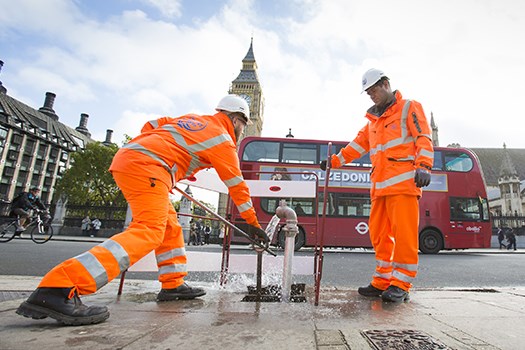Free-Flowing Digital Migration for Thames Water

Background
Thames Water, the largest utility in the UK, serves more than 15 million customers across London and the Thames Valley region. The Walton works are a critical part of the London water supply network. A pumping station was built in 1898 and upgraded in 1995 to the Advanced Water Treatment (AWT) technique.
Today, Walton AWT treats between 80 million and 100 million litres of water per day, and is one of five AWTWs on the Thames Water ring main, ensuring that the ever-increasing demand for high quality rinking water is met. Amid this effort, a recently installed digital radio system is playing an important behind-the-scenes role.
Problems with Analog
The 15-acre Walton works previously relied on a trio of radio communication solutions: analogue two-way radios were used by staff for in-building communications; where two-way radio coverage was not achievable, personnel also carried mobile phones.
Finally, pagers were used with a SCADA (supervisory control and data acquisition) system to raise alerts on equipment failures.
However, the nature and size of the site and the architectural mix of buildings had an adverse effect on the coverage capabilities of the system.
The previous solution did not provide 100 per cent site coverage – some areas did not support mobile coverage, while certain unique in-building conditions posed issues of interference making the radio handsets inoperable. The previous system was also less accurate in terms of the location of workers.
Migration to Digital (DMR) for 100% Coverage
Replacing the analogue system, the new Hytera DMR solution fills in the previous coverage gaps, providing 100 percent coverage on the site, even in 'the crypt' and areas where traditional communications systems could negatively influence alarm systems.
In Walton's complex and hazardous environment, the X1p handsets are delivering other benefits, namely in lone worker safety in numerous areas where mobile phones don't work and communications are difficult. The X1p's rugged IP67 feature provides the much needed blanket coverage and safety through the integration of a third-party app – a localisation system.
Hytera X1p - Geolocation and More
The selection of the Hytera X1p enabled the deployment of a new geolocation system. Deployed around live operations, PMR Products' SafetyNet Locator is a real-time mapping system which tracks and records the location and movement of radio users in both indoor and outdoor environments, based on a network of beacons. Once the radio signal is received by the control room, if it is manned and there are people on the site, you can easily locate those individuals and send the relevant help.
The X1p handsets are also integrated into the main telephone system so that calls can be transferred to the radios, which can also receive voice messages. Blackwell explains that this is especially useful when the radios are accidentally taken home or found to be in a prohibited area.
A Visible Difference
With the new solution in place, combining a state-of-the art location network and digital radio system, Thames Water operatives now have a compact, handheld device they carry with them that does 'everything', replacing three communication devices. The ease of installing the beacons meant the system was installed in days and operating shortly thereafter with minimal training.
The simplicity of the system and the on-going advantages of digital radio are encouraging Thames Water to consider rolling it out across other water treatment plants so there is a common network across the whole of West London.
